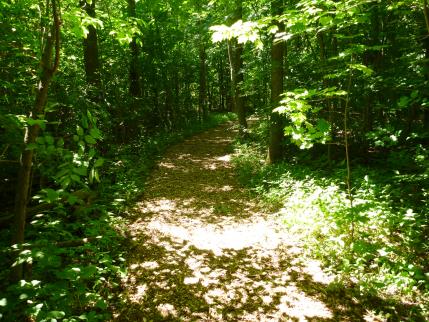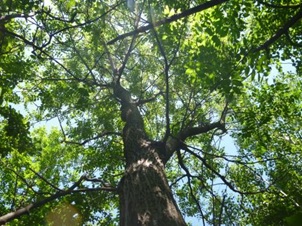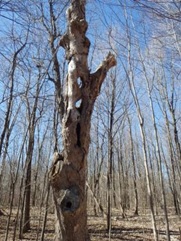| Environmental Columns
Terra-Cotta Natural Park: a wide range of plant life to be discovered
Terra-Cotta Natural Park is a unique environment containing over 250 plant species, including trees that are nearly 200 years old. This large natural forest contributes to the sustainability of Pointe-Claire’s ecosystems and provides residents with an oasis of greenery and oxygen.

A trail in Terra-Cotta Natural Park © Nature-Action Québec
Taking steps to protect and enhance wooded areas, such as natural parks in residential areas, is essential for the preservation of biodiversity in an urban environment.

Butternut (Juglans cinerea) © Nature-Action Québec
A biological inventory was carried out in the park to catalogue wildlife and plant species and identify areas of interest. A total of 221 plant species were identified, including 37 tree species. The park includes two tree species likely to be listed under Quebec’s Act Respecting Threatened or Vulnerable Species: the shagbark hickory (Carya ovata), found mainly along the stream, and the butternut (Juglans cinerea).
The park’s stream, its various wet zones, its unique topography and its clay soil all contribute to a wide variety of plant life.
The forest is composed mainly of ash trees (especially red ash – Fraxinus pennsylvanica), poplar (especially large eastern cottonwood trees – Populus deltoides), red maple (Acer rubrum), sugar maple (Acer saccharum), and red oak (Quercus rubra).
The maple population is mostly concentrated in the north-eastern section of the park. It is a century-old forest, composed mainly of mature trees between 120 and 189 years old. The two oldest trees in the park are a sugar maple, assessed at 189 years old, and a bur oak measuring 93 centimetres in diameter.
As you walk along the trails, you will notice snags, i.e., standing dead trees used by wildlife for food, shelter and reproduction. The pileated woodpecker (Dryocopus pileatus) comes to the snags to eat insect larvae that feed on dead wood.
All of these elements are part of the diverse plant life in Terra-Cotta Natural Park, making this a unique forest that serves as a haven for wildlife.

Snag © Nature-Action Québec

Column prepared with the financial support of the CN EcoConnexions – From the Ground Up program
